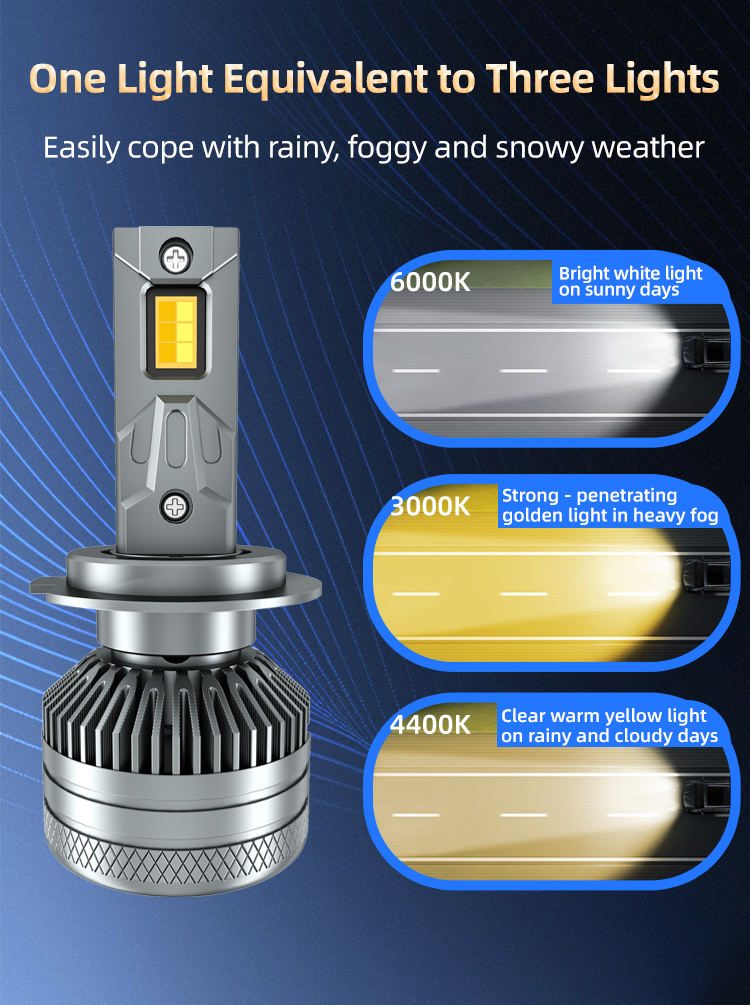Halogen bulbs can be replaced with LED bulbs. As for safety hazards, they only arise when modifying the circuitry. However, with genuine parts and standard modification techniques, these risks can be minimized.
In recent years, LED lighting technology has advanced rapidly, with the power of individual chips increasing rapidly. LED bulbs can completely replace halogen and xenon lamps in cars. Currently, there are a large number of LED bulbs available worldwide that can directly replace halogen lamps. These LED bulbs are highly integrated and very compact. Heat dissipation can be achieved using fans or braided copper. If the circuitry and heat dissipation system are well designed, LED bulbs can last longer than halogen lamps.
However, most people who directly switch to LED bulbs have discovered a problem: LED bulbs don’t blind people!
In other words, oncoming drivers experience a bright, even brighter light than xenon lamps. However, you can’t see the road clearly because the light is scattered and even on uneven, spotty roads. LED bulbs also have another problem: light decay! When installed, the bulb is very bright, but over time, the brightness gradually decreases. This light decay is irreversible, and LED bulbs that have lost brightness must be discarded because the LED has burned out! There are two reasons why people avoid the main road: one is insufficient bulb power, resulting in insufficient brightness and low lumen output. Another reason is the bulb parameters and the modification process.
Underpowered bulbs naturally fail to meet standard brightness, or the quality of the LED chip can affect the LED’s luminous efficiency. The problem with LED bulb parameters is actually due to the different lighting methods of LED bulbs, which are caused by the difference between the flat light source and the angle of the bulb. Halogen lamps, due to their filaments, emit light 360 degrees, with nearly uniform light intensity in any direction at the same distance, similar to a point source. The reflector in the original headlight is designed based on halogen bulbs, with the optical center of the halogen lamp located precisely at the focal point of the reflector.
The scattered light is reflected by the reflector and emitted evenly, just like the front. The optical center position of the replaced LED bulb is different from that of the halogen bulb, resulting in poor light uniformity and uneven distribution. If the LED bulb is underpowered, the lighting effect will be even worse! Therefore, when modifying LED bulbs, pay attention to the position of the optical center and install a lens with the appropriate focal length to achieve more uniform light and satisfactory lighting results.
Miscellaneous LED bulbs suffer from severe light decay: initially, the bulbs will appear bright, but over time, the brightness will gradually decrease. This is directly related to the quality of the LED driver. A good LED driver ensures that the LED bulb operates within critical conditions, ensuring both brightness and lifespan. To achieve higher brightness, the driving current of miscellaneous LED bulbs should not be increased. However, LED resistance exhibits a negative temperature coefficient, meaning it gradually decreases as the LED temperature rises.
If the operating voltage across the LED remains constant despite this resistance reduction, the operating current will increase. When the critical current is exceeded, the LED chip will burn out or experience severe light decay. Poor-quality LED drivers may not guarantee that the LEDs always operate at the rated current, or may have poor LED consistency, making the driver inappropriate for LED bulbs with varying parameters. As a result, some LED bulbs will fail prematurely, while others will last a long time. LED chips with different parameters also have different ultimate lifespans.

So, when replacing LEDs, avoid buying cheap, lesser-known, and inferior products. Instead, opt for reputable, reputable brands. While they may be more expensive, they are still very cost-effective in the long run. When replacing an LED bulb, ensure the plug is clean, the contacts are free of rust, and the plug is properly tightened. In most cases, no circuit changes are required. When replacing an LED bulb, pay attention to heat dissipation. Fans can burn out due to the impact of the fan, so when installing the lamp, try to leave heat dissipation holes for the bulb. Good heat dissipation can extend the life of the LED bulb.
Post time: Jul-25-2025







